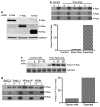Oncogenic K-Ras requires activation for enhanced activity
- PMID: 23334325
- PMCID: PMC3923400
- DOI: 10.1038/onc.2012.619
Oncogenic K-Ras requires activation for enhanced activity
Abstract
Oncogenic Ras mutations are widely considered to be locked in a permanent 'On' state and 'constitutively active'. Yet, many healthy people have cells possessing mutant Ras without apparent harm, and in animal models mutant Ras causes transformation only after upregulation of Ras activity. Here, we demonstrate that oncogenic K-Ras is not constitutively active but can be readily activated by upstream stimulants to lead to prolonged strong Ras activity. These data indicate that in addition to targeting K-Ras downstream effectors, interventions to reduce K-Ras activation may have important cancer-preventive value, especially in patients with oncogenic Ras mutations. As other small G proteins are regulated in a similar manner, this concept is likely to apply broadly to the entire Ras family of molecules.
Conflict of interest statement
The authors declare no conflict of interest.
Figures


References
-
- Scheffzek K, Ahmadian MR, Kabsch W, Wiesmuller L, Lautwein A, Schmitz F, et al. The Ras-RasGAP complex: structural basis for GTPase activation and its loss in oncogenic Ras mutants. Science. 1997;277:333–338. - PubMed
Publication types
MeSH terms
Substances
Grants and funding
LinkOut - more resources
Full Text Sources
Other Literature Sources
Research Materials
Miscellaneous

